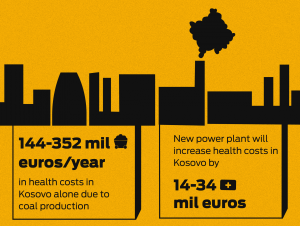

A planned coal-powered plant will only increase healthcare costs in Kosovo, a new report finds. Similar trends are also noticeable throughout the coal-dependent region.
Coal-fired power plants in Kosovo are adding 144-352 million euros per year to the cost of healthcare, according to a European environmental group.
A new report published by Brussels based NGO Health and Environment Alliance (HEAL), a consortium of health organizations, describes major health and financial implications for Kosovo, as well as the entire coal-dependent region.
 A planned plant intended to replace the fifty year old Kosovo A will increase these costs by 14-34 million euros per year, the report projects.
A planned plant intended to replace the fifty year old Kosovo A will increase these costs by 14-34 million euros per year, the report projects.
Kosovo has the highest dependency on coal in the Western Balkans, using it for 85% of energy consumption. Lignite, the dirtiest kind of coal, is used in Kosovo exclusively, making the country the fifth largest producer of lignite in the world.
Two power plants, Kosovo A (built in 1962) and B (built in 1983), are located close to Prishtina and produce 97% of the country’s energy. The existing plants, have a cumulative capacity of 1,080 MegaWatt electric (MWe) and the planned plant (Kosova e Re) will have an additional 500MWe.
ContourGlobal, a multi-million dollar energy company out of the USA, has already secured the tender for Kosova e Re.
Lignite, used in Kosovo, is considered an inferior form of coal that yields 100 premature deaths per terawatt-hour (a unit of energy to measure one terawatt of power over one hour) in the Western Balkans. In comparison there are only 33 premature deaths per terawatt-hour due to lignite in the USA or EU.
HEAL attributes this difference to, “the lack of filters in Western Balkan plants.” They go on to explain that some new filters can remove between 10-30% of Particulate Matter (PM).
 In the region, Kosovo is the largest producer of PM2.5, a tiny pollutant considered the most detrimental to health because it is small enough to enter the bloodstream.
In the region, Kosovo is the largest producer of PM2.5, a tiny pollutant considered the most detrimental to health because it is small enough to enter the bloodstream.
Kosovo plants produce about 7,538 tonnes of PM2.5 per year, with 4,851 from Kosovo A alone, compared to the second highest producer (Serbia) at 4,757 tonnes per year.
The opening of Kosova e Re will eliminate Europe’s largest polluting plant, Kosovo A, while its sibling Kosovo B is planned to be upgraded.
Despite measures to limit the environmental damage from Kosova e Re, experts state that the new plant will only prolong Kosovo’s fossil fuel dependency and the health effects on the populous.

Coal-fired power plants in Bosnia and Herzegovina, Kosovo, Macedonia, Montenegro and Serbia have a current accompanying health cost between 2.9-8.5 billion euros per year with a projected increase of 73-204 million euros per year due to plans for further power-plant construction, according to HEAL.
The pollution in the Western Balkans affects not just regional neighbors but also the rest of Europe. “Total damage to health in Europe from coal power plants in the Western Balkans is estimated at between 2.9 and 8.5 billion EUR per year,” states the report.
Illustrations by Jeta Dobranja/Trembelat.
18 March 2016 - 12:07

Named for its purity and as a symbol of natural beauty, the Drini i Ba...

In Kosovo, a pioneering project supported by the Swiss Agency for Deve...

In Kosovo, Serb doctors treat Albanians, and Albanian doctors treat Se...

Lack of trained specialists means the trauma ward at UAE-funded childr...